Science Notes
UNIVERSE Notes 9th Science Lesson 12 Notes in English
UNIVERSE
Introduction
- In the earlier days, before the invention of astronomical instruments, people thought that Earth is the centre of all the objects in the space.
- This was known as the geocentric model, held by Greek astronomer Ptolemy (2nd Century), Indian astronomer Aryabhatta (5th Century) and many astronomers around the world.
- Later Polish astronomer Nicolaus Copernicus proposed the heliocentric model (helios = Sun), with Sun at the centre of the solar system.
- Invention of the telescope in the Netherlands, in 1608, created a revolution in astronomy.
- In this lesson, we will study about the building blocks of the universe, Kepler’s laws of motion, time period of satellites and International Space Station (ISS).
Building block of the Universe
- The basic constituent of the universe is luminous matter i.e., galaxies which are really the collection of billions of stars.
- The universe contains everything that exists including the Earth, planets, stars, space, and galaxies.
- This includes all matter, energy and even time. No one knows how big the universe is.
- It could be infinitely large. Scientists, however, measure the size of the universe by what they can see. This is called the ‘observable universe’.
- The observable universe is around 93 billion light years (1 light year = the distance that light travels in one year, which is 9.4607 × 1012 km) across.
- One of the interesting things about the universe is that it is currently expanding. It is growing larger and larger all the time.
- Not only is it growing larger, but the edge of the universe is expanding at a faster and faster rate.
- However, most of the universe what we think of is empty space. All the atoms together only make up around four percent of the universe.
- The majority of the universe consists of something scientists call dark matter and dark energy.
Age of the Universe
- Scientists think that the universe began with the start of a massive explosion called the Big Bang.
- According to Big Bang theory, all the matter in the universe was concentrated in a single point of hot dense matter.
- About 13.7 billion years ago, an explosion occurred and all the matter were ejected in all directions in the form of galaxies.
- Nearly all of the matter in the universe that we understand is made of hydrogen and helium, the simplest elements, created in the Big Bang.
- The rest, including the oxygen, the carbon, calcium, and iron, and silicon are formed in the cores of stars.
- The gravity that holds these stars together generally keeps these elements deep inside their interiors.
- When these stars explode, these fundamental building blocks of planetary systems are liberated throughout the universe.
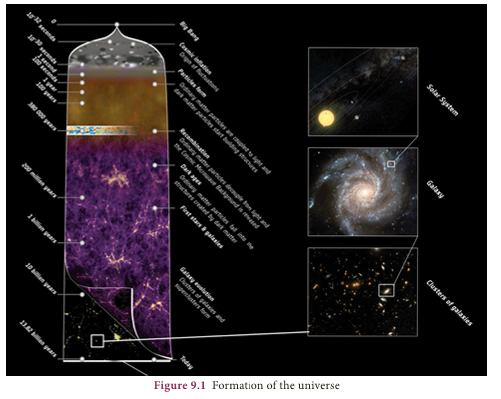
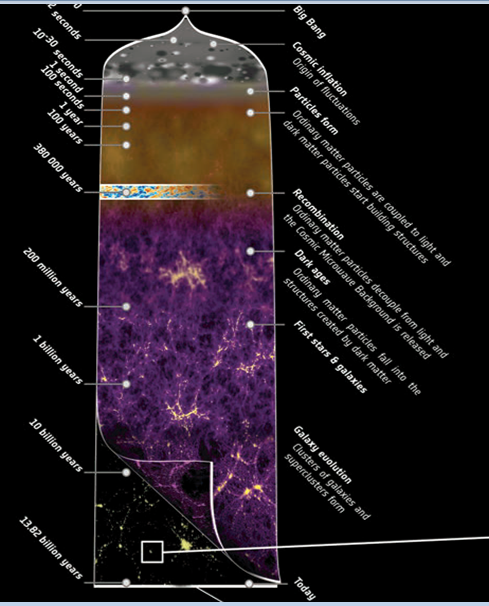
Galaxies
- Immediately after the Big Bang, clouds of gases began to compress under gravity to form the building blocks of galaxies.
- A galaxy is a massive collection of gas, dust, and billions of stars and their solar systems.
- Scientists believe that there are one hundred billion (1011) galaxies in the observable universe.
- Galaxies are also in different shapes. Depending on their appearance, galaxies are classified as spiral, elliptical, or irregular.
- Galaxies occur alone or in pairs, but they are more often parts of groups, clusters, and super clusters.
- Galaxies in such groups often interact and even merge together.
- Our Sun and all the planets in the solar system are in the Milky Way galaxy.
- There are many galaxies besides our Milky Way. Andromeda galaxy is our closest neighbouring galaxy.
- The Milky Way galaxy is spiral in shape.
- It is called Milky Way because it appears as a milky band of light in the sky.
- It is made up of approximately 100 billion stars and its diameter is 1,00,000 light years.
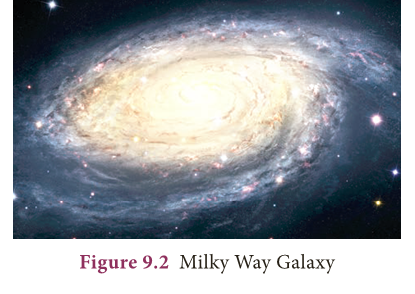
- Our solar system is 25,000 light years away from the centre of our galaxy.
- Just as the Earth goes around the Sun, the Sun goes around the centre of the galaxy and it takes 250 million years to do that.
Stars
- Stars are the fundamental building blocks of galaxies. Stars were formed when the galaxies were formed during the Big Bang.
- Stars produce heat, light, ultraviolet rays, x-rays, and other forms of radiation.
- They are largely composed of gas and plasma (a superheated state of matter).
- Stars are built by hydrogen gases.
- Hydrogen atoms fuse together to form helium atoms and in the process they produce large amount of heat.
- In a dark night we can see nearly 3,000 stars with the naked eye. We don’t know how many stars exist.
- Our universe contains more than 100 billion galaxies, and each of those galaxies may have more than 100 billion stars.
- Though the stars appear to be alone, most of the stars exist as pairs.
- The brightness of a star depends on their intensity and the distance from the Earth.
- Stars also appear to be in different colours depending on their temperature.
- Hot stars are white or blue, whereas cooler stars are orange or red in colour.
- They also occur in many sizes.
- A group of stars forms an imaginary outline or meaningful pattern on the space.
- They represent an animal, mythological person or creature, a god, or an object.
- This group of stars is called constellations.
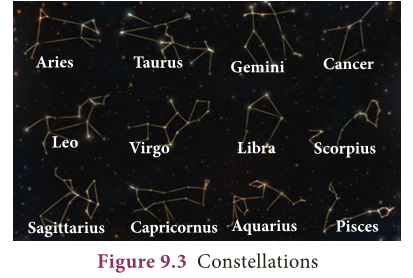
- People in different cultures and countries adopted their own sets of constellation outlines.
- There are 88 formally accepted constellations. Aries, Gemini, Leo, Orion, Scorpius and Cassiopeia are some of the constellations.
The Solar System
- Sun and the celestial bodies which revolve around it form the solar system.
- It consists of large number of bodies such as planets, comets, asteroids and meteors.
- The gravitational force of attraction between the Sun and these objects keep them revolving around it.
The Sun
- The Sun is a medium sized star, a very fiery spinning ball of hot gases.
- Three quarters of the Sun has hydrogen gas and one quarter has helium gas. It is over a million times as big as the Earth.
- Hydrogen atoms combine or fuse together to form helium under enormous pressure.
- This process, called nuclear fusion releases enormous amount of energy as light and heat.
- It is this energy which makes Sun shine and provide heat. Sun is situated at the centre of the solar system.
- The strong gravitational fields cause other solar matter, mainly planets, asteroids, comets, meteoroids and other debris, to orbit around it.
- Sun is believed to be more than 4.6 billion years old.
Formation of the Sun
- At the time of the Big Bang, hydrogen gas condensed to form huge clouds, which later concentrated and formed the numerous galaxies.
- Some of the hydrogen gas was left free and started floating around in our galaxy.
- With time, due to some changes, this free-floating hydrogen gas concentrated and paved way for the formation of the Sun and solar system.
- Gradually, the Sun and the solar system turned into a slowly spinning molecular cloud, composed of hydrogen and helium along with dust.
- The cloud started to undergo the process of compression, as a result of its own gravity.
- Its excessive and high-speed spinning ultimately resulted in its flattening into a giant disc.
Planets
- A planet revolves around the Sun along a definite curved path which is called an orbit. It is elliptical.
- The time taken by a planet to complete one revolution is called its period of revolution.
- Besides revolving around the Sun, a planet also rotates on its own axis like a top.
- The time taken by a planet to complete one rotation is called its period of rotation.
- The period of rotation of the Earth is 23 hours and 56 minutes and so the length of a day on Earth is taken as 24 hours.
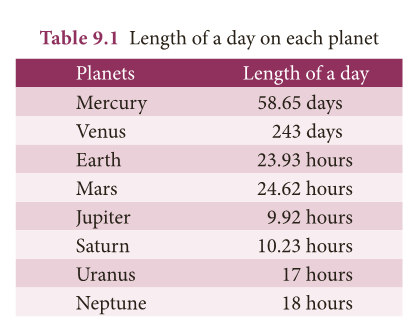
- Table 9.1 tells about the length of a day on each planet. The planets are spaced unevenly.
- The first four planets are relatively close together and close to the Sun. They form the inner solar system.
- Farther from the Sun is the outer solar system, where the planets are much more spread out.
- Thus the distance between Saturn and Uranus is much greater (about 20 times) than the distance between the Earth and the Mars.
- The four planets grouped together in the inner solar system are Mercury, Venus, Earth and Mars. They are called inner planets.
- They have a surface of solid rock crust and so are called terrestrial or rocky planets.
- Their insides, surfaces and atmospheres are formed in a similar way and form similar pattern.
- Our planet, Earth can be taken as a model of the other three planets.
- The four large planets Jupiter, Saturn, Uranus and Neptune spread out in the outer solar system and slowly orbit the Sun are called outer planets.
- They are made of hydrogen, helium and other gases in huge amounts and have very dense atmosphere.
- They are known as gas giants and are called gaseous planets.
- The four outer planets Jupiter, Saturn, Uranus and Neptune have rings whereas the four inner planets do not have any rings.
- The rings are actually tiny pieces of rock covered with ice.
- Now let us learn about each planet in the solar system.
Mercury:
- Mercury is a rocky planet nearest to the Sun. It is very hot during day but very cold at night.
- Mercury can be easily observed thorough telescope than naked eye since it is very faint and small.
- It always appears in the eastern horizon or western horizon of the sky.
Venus:
- Venus is a special planet from the Sun, almost the same size as the Earth.
- It is the hottest planet in our solar system.
- After our moon, it is the brightest heavenly body in our night sky.
- This planet spins in the opposite direction to all other planets.
- So, unlike Earth, the Sun rises in the west and sets in the east here.
- Venus can be seen clearly through naked eye.
- It always appears in the horizon of eastern or western sky.
The Earth:
- The Earth where we live is the only planet in the solar system which supports life.
- Due to its right distance from the Sun it has the right temperature, the presence of water and suitable atmosphere and a blanket of ozone.
- All these have made continuation of life possible on the Earth.
- From space, the Earth appears bluish green due to the reflection of light from water and land mass on its surface.
Mars:
- The first planet outside the orbit of the Earth is Mars.
- It appears slightly reddish and therefore it is also called the red planet.
- It has two small natural satellites (Deimos and Phobos).
Jupiter:
- Jupiter is called as Giant planet.
- It is the largest of all planets (about 11 times larger and 318 times heavier than Earth). It has 3 rings and 65 moons.
- Its moon Ganymede is the largest moon of our solar system.
Saturn:
- Known for its bright shiny rings, Saturn appears yellowish in colour.
- It is the second biggest and a giant gas planet in the outer solar system.
- At least 60 moons are present – the largest being Titan. Titan is the only moon in the solar system with clouds.
- Having least density of all (30 times less than Earth), this planet is so light.
Uranus:
- Uranus is a cold gas giant and it can be seen only with the help of large telescope.
- It has a greatly tilted axis of rotation.
- As a result, in its orbital motion it appears to roll on its side.
- Due to its peculiar tilt, it has the longest summers and winters each lasting 42 years.
Neptune:
- It appears as Greenish star.
- It is the eighth planet from the Sun and is the windiest planet. Every 248 years, Pluto crosses its orbit.
- This situation continues for 20 years.
- It has 13 moons – Triton being the largest.
- Triton is the only moon in the solar system that moves in the opposite direction to the direction in which its planet spins.
Other Bodies of the Solar System
- Besides the eight planets, there are some other bodies which revolve around the Sun.
- They are also members of the solar system.
Asteroids
- There is a large gap in between the orbits of Mars and Jupiter.
- This gap is occupied by a broad belt containing about half a million pieces of rocks that were left over when the planets were formed and now revolve around the Sun. These are called asteroids.
- The biggest asteroid is Ceres – 946 km across.
- Every 50 million years, the Earth is hit by an asteroid nearing 10 km across.
- Asteroids can only be seen through large telescope.
Comets
- Comets are lumps of dust and ice that revolve around the Sun in highly elliptical orbits. Their period of revolution is very long.
- When approaching the Sun, a comet vaporizes and forms a head and tail.
- Some of the biggest comets ever seen had tails 160 million (16 crores) km long.
- This is more than the distance between the Earth and the Sun.
- Many comets are known to appear periodically.
- One such comet is Halley’s Comet, which appears after nearly every 76 years.
- It was last seen in 1986.
- It will next be seen in 2062.
Meteors and Meteorites
- Meteors are small piece of rocks scattered throughout the solar system.
- Travelling with high speed, these small pieces come closer to the Earth’s atmosphere and are attracted by the gravitational force of Earth.
- Most of them are burnt up by the heat generated due to friction in the Earth’s atmosphere.
- They are called meteors.
- Some of the bigger meteors may not be burnt completely and they fall on the surface of Earth. These are called meteorites.
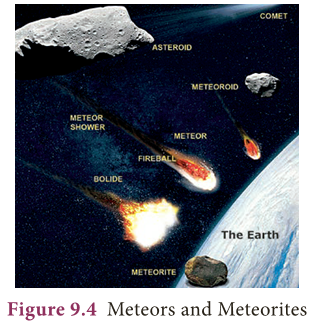
Satellites
- A body moving in an orbit around a planet is called satellite.
- In order to distinguish them from the man made satellites (called as artificial satellites), they are called as natural satellites or moons.
- Satellite of the Earth is called Moon (other satellites are written as moon).
- We can see the Earth’s satellite Moon, because it reflects the light of the Sun.
- Satellite moves around the planets due to gravity, and the centripetal force.
- Among the planets in the solar system all the planets have moons except Mercury and Venus.
Orbital Velocity
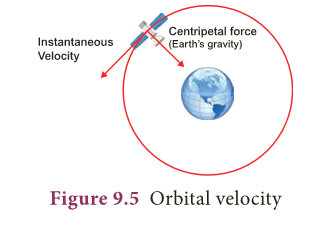
- We saw that there are natural satellites moving around the planets.
- There will be gravitational force between the planet and satellites.
- Nowadays many artificial satellites are launched into the Earth’s orbit.
- The first artificial satellite Sputnik was launched in 1956.
- India launched its first satellite Aryabhatta on April 19, 1975.
- Artificial satellites are made to revolve in an orbit at a height of few hundred kilometres.
- At this altitude, the friction due to air is negligible.
- The satellite is carried by a rocket to the desired height and released horizontally with a high velocity, so that it remains moving in a nearly circular orbit.
- The horizontal velocity that has to be imparted to a satellite at the determined height so that it makes a circular orbit around the planet is called orbital velocity.
- The orbital velocity of the satellite depends on its altitude above Earth.
- Nearer the object to the Earth, the faster is the required orbital velocity.
- At an altitude of 200 kilometres, the required orbital velocity is little more than 27,400 kph.
- That orbital speed and distance permit the satellite to make one revolution in 24 hours.
- Since Earth also rotates once in 24 hours, a satellite stays in a fixed position relative to a point on Earth’s surface.
- Because the satellite stays over the same spot all the time, this kind of orbit is called ‘geostationary’.
- Orbital velocity can be calculated using the following formula.
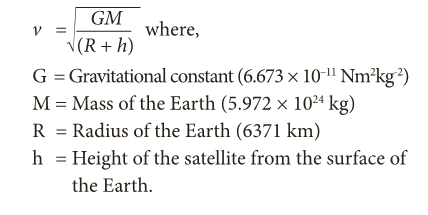
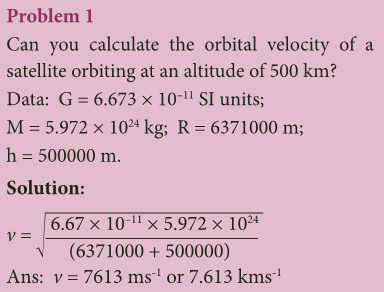
Time period of a Satellite
- Time taken by a satellite to complete one revolution round the Earth is called time period.

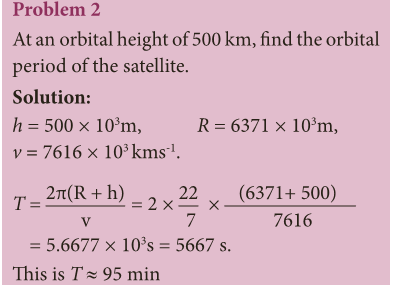
Kepler’s Laws
- In the early 1600s, Johannes Kepler proposed three laws of planetary motion.
- Kepler was able to summarize the carefully collected data of his mentor, Tycho Brahe with three statements that described the motion of planets in a Sun-centered solar system.
- Kepler’s efforts to explain the underlying reasons for such motions are no longer accepted; nonetheless, the actual laws themselves are still considered an accurate description of the motion of any planet and any satellite.
- Kepler’s three laws of planetary motion can be described as below.
First Law –
- The Law of Ellipses: All planets revolve around the Sun in elliptical orbits with Sun at one of their foci.
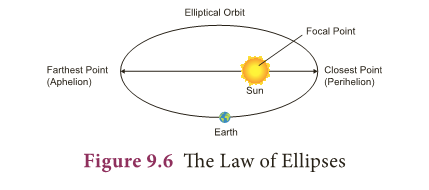
Second Law –
- The Law of Equal Areas: The line connecting the planet and the Sun covers equal areas in equal intervals of time.
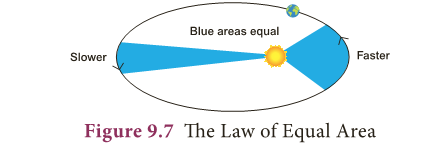
Third Law –
- The Law of Harmonies: The square of time period of revolution of a planet around the Sun is directly proportional to the cube of the distance between sun and the planets.
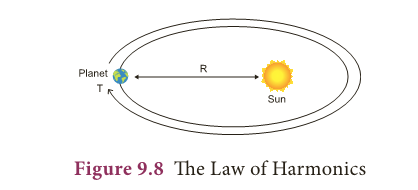
International Space Station
- ISS is a large spacecraft which can house astronauts.
- It goes around in low Earth orbit at approximately 400 km distance.
- It is also a science laboratory.
- Its very first part was placed in orbit in 1998 and its core construction was completed by 2011.
- It is the largest man-made object in space which can also be seen from the Earth through the naked eye.
- The first human crew went to the ISS in 2000. Ever since that, it has never been unoccupied by humans.
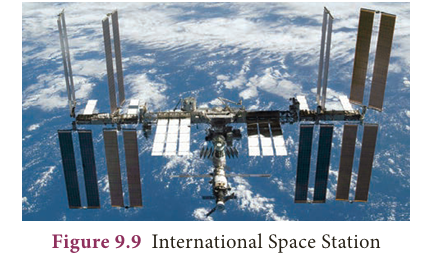
- At any given instant, at least six humans will be present in the ISS.
- According to the current plan, ISS will be operated until 2024, with a possible extension until 2028.
- After that, it could be deorbited, or recycled for future space stations.
Benefits of ISS
- According to NASA, the following are some of the ways in which the ISS is already benefitting us or will benefit us in the future.
Supporting water-purification efforts
- Using the technology developed for the ISS, areas having water scarcity can gain access to advanced water filtration and purification systems.
- The water recovery system (WRS) and the oxygen generation system (OGS) developed for the ISS have already saved a village in Iraq from being deserted due to lack of clean water.
Eye tracking technology
- The Eye Tracking Device, built for a microgravity experiment, has proved ideal to be used in many laser surgeries.
- Also, eye tracking technology is helping disabled people with limited movement and speech.
- For example, a kid who has severe disability in body movements can use his eye-movements alone and do routine tasks and lead an independent life.
Robotic arms and surgeries
- Robotic arms developed for research in the ISS are providing significant help to the surgeons in removing inoperable tumours (e.g., brain tumours) and taking biopsies with great accuracies.
- Its inventors say that the robot could take biopsies with remarkable precision and consistency.
- Apart from the above-mentioned applications, there are many other ways in which the researches that take place in the ISS are helpful.
- They are: development of improved vaccines, breast cancer detection and treatment, ultrasound machines for remote regions etc,.
ISS and International Cooperation
- As great as the ISS’ scientific achievements are, no less in accomplishment is the international co-operation which resulted in the construction of the ISS.
- An international collaboration of five different space agencies of 16 countries provides, maintains and operates the ISS.
- They are: NASA (USA), Roskosmos (Russia), ESA (Europe), JAXA (Japan) and CSA (Cananda).
- Belgium, Brazil, Denmark, France, Germany, Italy, Holland, Norway, Spain, Sweden, Switzerland and the UK are also part of the consortium.
MORE TO KNOW:
Andromeda
- The distance of Andromeda, our nearest galaxy is approximately 2.5 million light-years.
- If we move at the speed of the Earth (30 km/s), it would take us 25 billion years to reach it!
The Sun
- The Sun travelling at a speed of 250 km per second (9 lakh km/h) takes about 225 million years to complete one revolution around the Milky Way.
- This period is called a cosmic year.
Microgravity
- Microgravity is the condition in which people or objects appear to be weightless.
- The effects of microgravity can be seen when astronauts and objects float in space.
- Micro- means very small, so microgravity refers to the condition where gravity ‘seems’ to be very small.
Stars
- All stars appear to us as moving from east to west, where as there is one star which appears to us stationary in its position.
- It has been named as Pole star.
- The pole star appears to us as fixed in space at the same place in the sky in the north direction because it lies on the axis of rotation of the Earth which itself is fixed and does not change its position in space.
- It may be noted that the pole star is not visible from the southern hemisphere.
EXTRA POINTS:
- Asteroid: Small, rocky object orbiting the Sun.
- Comet: A chunk of dirty, dark ice, mixed with dust which revolves around the Sun.
- Constellation: A group of stars that can be seen as a pattern from Earth.
- Galaxy: A group of stars, nebulae, star clusters, globular clusters and other matter.
- Meteor: A meteoroid that travels through the Earth’s atmosphere.
- Meteorite: A meteor that hits the Earth’s surface.
- Milky Way: A broad band of light that looks like a trail of spilled milk in the night sky.
- Moon: Any natural object which orbits a planet.
- Planet: A relatively large object that revolves around a star, but which is not itself a star.
- Satellite: Any object in outer space that orbits another object.
- Space station: A large, manned satellite in space used as a base for space exploration.
- Star: A ball of constantly exploding gases, giving off light and heat.
- Universe: Everything in space, including the galaxies and stars, the Milky Way and the Solar System.